Related Research Articles

The .308 Winchester is a smokeless powder rimless bottlenecked rifle cartridge widely used for hunting, target shooting, police, military, and personal protection applications globally. It is similar, but not identical, to the 7.62×51mm NATO cartridge.

The .460 Weatherby Magnum is a belted, bottlenecked rifle cartridge, developed by Roy Weatherby in 1957. The cartridge is based on the .378 Weatherby Magnum necked up to accept the .458-inch (11.6 mm) bullet. The original .378 Weatherby Magnum parent case was inspired by the .416 Rigby. The .460 Weatherby Magnum was designed as an African dangerous game rifle cartridge for the hunting of heavy, thick skinned dangerous game.
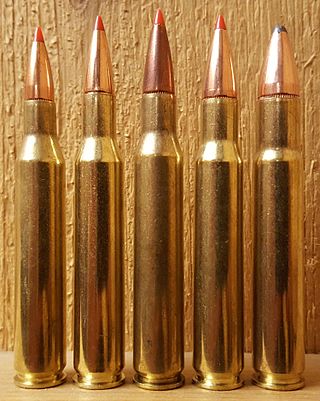
The .270 Winchester is a rifle cartridge developed by Winchester Repeating Arms Company in 1923, and it was unveiled in 1925 as a chambering for their bolt-action Model 54 to become arguably the flattest shooting cartridge of its day, only competing with the .300 Holland & Holland Magnum, also introduced in the same year.
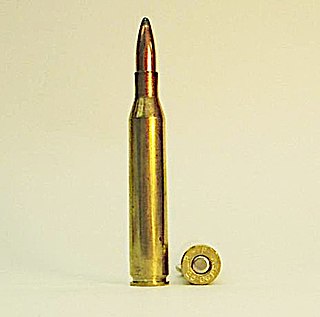
The .25-06 Remington was a wildcat cartridge for nearly half a century before being standardized by Remington in 1969.

The 7mm-08 Remington is a rifle cartridge that is almost a direct copy of a wildcat cartridge developed around 1958 known as the 7mm/308. As these names would suggest, it is the .308 Winchester case necked down to accept 7 mm (.284) bullets with a small increase in case length. Of cartridges based upon the .308, it is the second most popular behind only the .243 Winchester. However, the .308 is more popular than both. In 1980, the Remington Arms company popularized the cartridge by applying its own name and offering it as a chambering for their Model 788 and Model 700 rifles, along with a limited-run series within their Model 7600 pump-action rifles during the early 2000s.
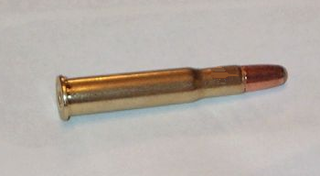
The .30-30 Winchester / 7.8x51mmR cartridge was first marketed for the Winchester Model 1894 lever-action rifle in 1895. The .30-30, as it is most commonly known, along with the .25-35 Winchester, was offered that year as the United States' first small-bore sporting rifle cartridges designed for smokeless powder. Since its introduction, it has been utilized alongside the development of flatter shooting cartridges, most prominently those derived from designs subsidized by interest in military expenditures. The .30-30 has remained in widespread use almost entirely because of reliable effectiveness in civilian applications, and has put food on the table for millions of people in hunting situations.
The .204 Ruger is a centerfire rifle cartridge developed by Hornady and Ruger. At the time of its introduction in 2004, the .204 Ruger was the second-highest velocity commercially produced ammunition and the only centerfire cartridge produced commercially for bullets of .204 inch/5 mm caliber.
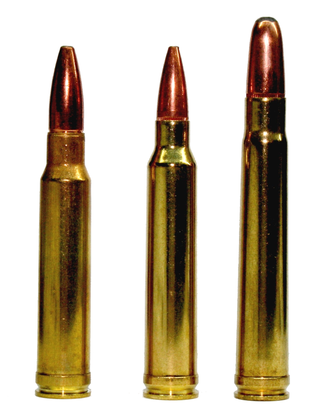
The .300 Winchester Magnum is a belted, bottlenecked magnum rifle cartridge that was introduced by the Winchester Repeating Arms Company in 1963. The .300 Winchester Magnum is a magnum cartridge designed to fit in a standard rifle action. It is based on the .375 H&H Magnum, which has been blown out, shortened, and necked down to accept a .30 caliber (7.62 mm) bullet.

The .444 Marlin (10.9×57mmR) is a rifle cartridge designed in 1964 by Marlin Firearms and Remington Arms. It was designed to fill the gap left when the older .45-70 cartridge was not available in new lever-action rifles; at the time it was the largest lever-action cartridge available. The .444 resembles a lengthened .44 Magnum and provides a significant increase in velocity. It is usually used in the Marlin 444 lever-action rifle. Currently, Marlin, now owned by Ruger Firearms, does not offer the .444 chambering in any of their rifles. It remains to be seen if they will bring the chambering back into production.
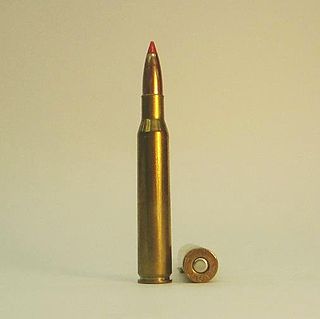
The .280 Remington, also known as the 7mm-06 Remington and 7mm Express Remington, was introduced in 1957 for the Remington model 740, 760, 721, and 725 rifles.

The 7mm Remington Magnum rifle cartridge was introduced as a commercially available round in 1962, along with the new Remington Model 700 bolt-action rifle. It is a member of the belted magnum family that is directly derived from the venerable .375 H&H Magnum. The original purpose of the belted magnum concept taken from the .300 H&H Magnum and .375 H&H Magnum, was to provide precise headspace control, since the sloping shoulders, while easing cartridge extraction, were unsuitable for this purpose. Improved cartridge extraction reliability is desirable while hunting dangerous game, in particular when a fast follow-up shot is required. The 7mm Remington Magnum is based on the commercial .264 Winchester Magnum, .338 Winchester Magnum, and .458 Winchester Magnum, which were based on the same belted .300 H&H Magnum and .375 H&H Magnum cases, trimmed to nearly the same length as the .270 Weatherby Magnum.

The 6mm Remington rifle cartridge, originally introduced in 1955 by Remington Arms Company as the .244 Remington, is based on a necked down .257 Roberts cartridge using a .24/6mm bullet. Known for a combination of high velocity, long range, flat trajectory, and accuracy, it is suitable as a dual use hunting cartridge for both medium-sized big game and varmints. When used in the less common earlier slow twist barrels, it offers exceptional range for varmint applications. While not as commercially popular today as the .243 Winchester, the 6mm Remington enjoys a slight ballistic advantage and continues to be popular with handloaders and custom rifle builders.
The .264 Winchester Magnum is a belted, bottlenecked rifle cartridge. Except for the .244 H&H Magnum and .257 Weatherby Magnum, it is the smallest caliber factory cartridge derived from the 2.85 in (72 mm) Holland & Holland belted magnum case. It was introduced in the late 1950s and early 1960s with the .338 Winchester Magnum and the .458 Winchester Magnum as one of a family of short-cased 2.5 in (64 mm) belted magnum cartridges developed by Winchester based on the .375 Holland & Holland parent case. It was officially introduced to the public by Winchester in 1959. After many years of dwindling use it began enjoying a mild resurgence in popularity in the mid-2000s among long range rifle enthusiasts and reloaders due to the high ballistic coefficient of the heavier 6.5mm bullets and increasing popularity of cartridges such as 6.5mm Creedmoor, .260 Remington, 6.5 Grendel, benchrest and wildcat cartridges in 6.5mm.
The .375 Ruger (9.5×65.5mm) is a rimless, standard-length rifle cartridge designed for hunting large, dangerous game. It is designed to provide an increase in performance over the .375 H&H cartridge within the context of a standard-length rifle action. The cartridge was designed in partnership by Hornady and Ruger. In 2007, it was released commercially and chambered in the Ruger Hawkeye African and the Ruger Hawkeye Alaskan rifles.
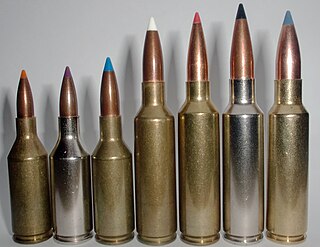
The .325 Winchester Short Magnum, commonly known as the 325 WSM, is an 8mm caliber rebated rim bottlenecked centerfire short magnum medium bore cartridge. The cartridge was introduced by Winchester Ammunition in 2005.
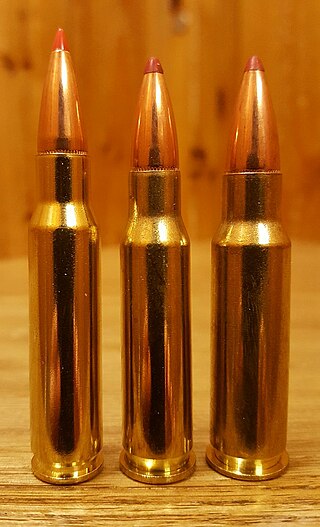
The .338 Marlin Express is a cartridge developed by Marlin Firearms and Hornady. It is based on the .376 Steyr with a goal to duplicate the venerable .30-06 Springfield's performance in a cartridge compatible with lever-action firearms. The cartridge uses a slightly shorter, rimmed case to function in lever-action rifles with tubular magazines. As introduced in Hornady's LEVERevolution line of cartridges, it follows the design logic of the .308 Marlin Express which preceded it. The .338MX fires heavier .338 caliber bullets than the .308 Marlin Express at roughly the same velocity. It is chambered in Marlin's Model 338MX and 338MXLR rifles using the Marlin Model 336 action.

A varmint rifle is a small-caliber precision firearm or high-powered airgun primarily used for both varmint hunting and pest control. These tasks include killing three types of pests or nuisance animals that spread diseases or destroy crops or livestock:
The .280 Ackley Improved was the result of the .280 Remington case modification by P.O Ackley, who pushed out the sidewalls at the shoulder to near parallel and steepened the shoulder angle to 40 degrees in order to increase powder capacity, thus along with increasing the allowable pressure, resulted in increasing the bullet initial velocity by approximately 100 fps.
Nosler produces six different rebated rim hunting cartridges. The first to be introduced was .26 Nosler, followed by .28 Nosler, .30 Nosler, .33 Nosler, .22 Nosler, and .27 Nosler.
The 6.8 Western is a centerfire rifle cartridge designed by Winchester Repeating Arms Company and Browning Arms Company. Introduced to the market in 2021 as a big game hunting cartridge that may be also used for long range target shooting.
References
- 1 2 "C.I.P. TDCC datasheet 7-30 Waters" (PDF). CIP. Archived from the original (PDF) on 2023-04-30.
- 1 2 3 Frank C. Barnes, ed. Stan Skinner (2003). Cartridges of the World, 10th Ed. Krause Publications. ISBN 0-87349-605-1.
- ↑ "Petersen's RifleShooter magazine, "The Saga of Seven"". Archived from the original on 2010-02-15. Retrieved 2011-11-04.
- ↑ "7-30 Waters", retrieved 2013 May 04
- ↑ Federal Premium Ammunition, retrieved 2012 May 15
- ↑ Hornady LEVERevolution, retrieved 2012 May 15
- ↑ "Speer Bullets, #1625 Hot-Cor, retrieved 2012 May 15". Archived from the original on 2011-11-10. Retrieved 2012-05-16.
- ↑ "Hornady FTX, retrieved 2012 May 15". Archived from the original on 2012-06-14. Retrieved 2012-05-16.
- ↑ "Hornady MonoFlex, retrieved 2012 May 15". Archived from the original on 2012-04-30. Retrieved 2012-05-16.
- ↑ "Winchester's Timeless Classic".
- ↑ "Custom Shop, retrieved 2012 May 12". Archived from the original on 2012-05-10. Retrieved 2012-05-16.
- ↑ "Gone But Not Forgotten".
- ↑ The Sectional Density of Rifle Bullets, retrieved 2012 May 18
- ↑ Hodgdon Data Manual, 26th Ed.
- ↑ "Nosler, Bullets, retrieved 2012 May 18". Archived from the original on 2010-06-29. Retrieved 2012-05-19.
- ↑ "Hornady, .284 7mm Products, retrieved 2012 May 18". Archived from the original on 2012-04-30. Retrieved 2012-05-19.
- ↑ "7mm International Rimmed". Archived from the original on 2008-12-12.
- ↑ "7-30 Waters" (PDF). Accurate Arms. Archived from the original (PDF) on 2008-11-20. Retrieved 2011-10-27.
- Ken Water's Pet Loads Eighth Edition; Book by Wolfe Publishing Co., Inc., 2001, p. 221-226
